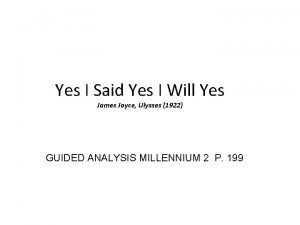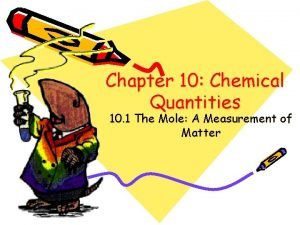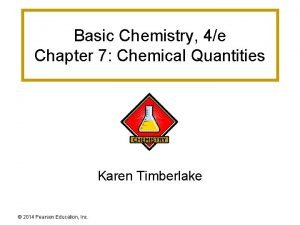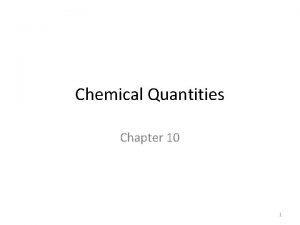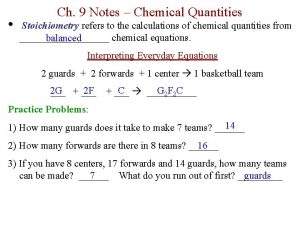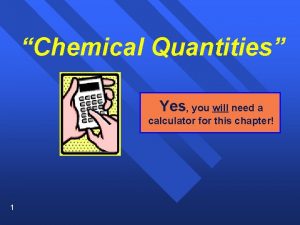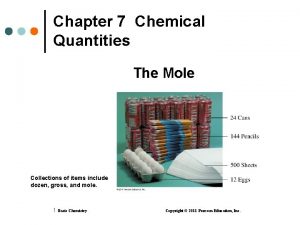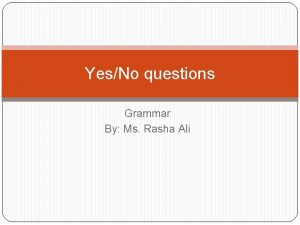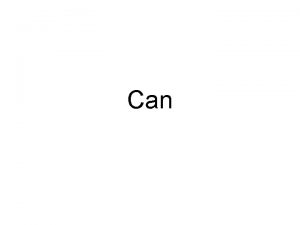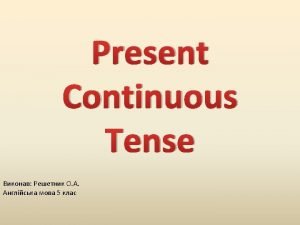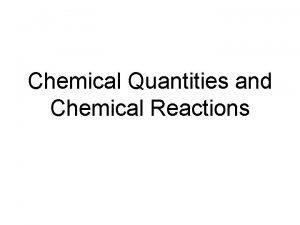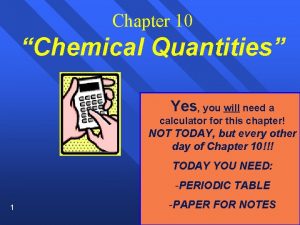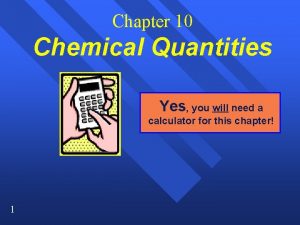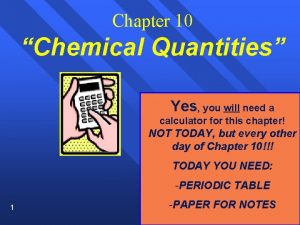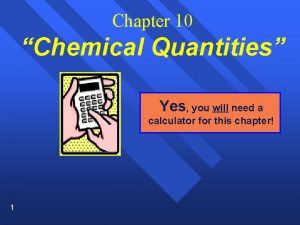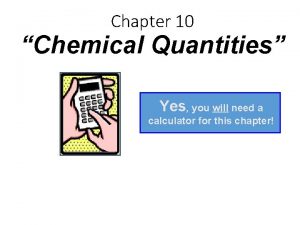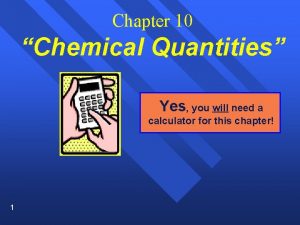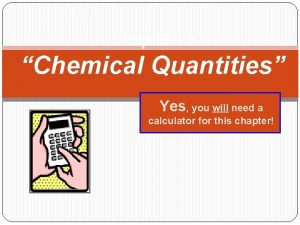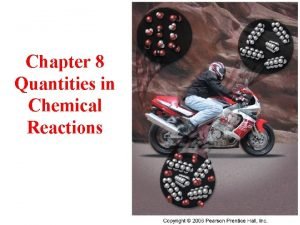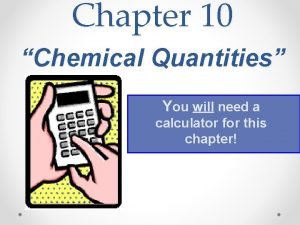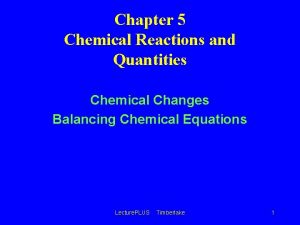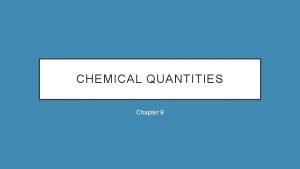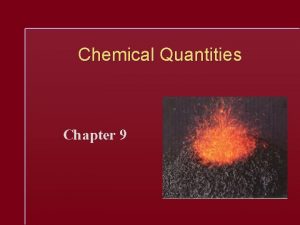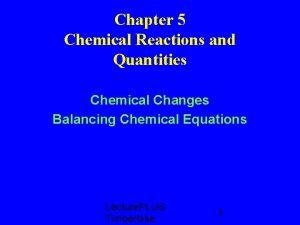Chapter 10 Chemical Quantities Yes you will need




































- Slides: 36

Chapter 10 “Chemical Quantities” Yes, you will need a calculator for this chapter! 1

Section 10. 1 Da Mole: A Measurement of Matter 2

How do we measure items? 3 § Measure mass in grams. § Measure volume in liters. § Measure amount in MOLES.

What is the mole? 4 We’re not talking about this kind of mole!

Moles (mol) § It is an amount. Defined as the number of carbon atoms in exactly 12 grams of carbon-12. 1 mole = 6. 02 x 1023 of representative particles. 6. 02 x 1023 is called: Avogadro’s number. § 1 mole = 6. 02 x 1023 = Avogadro’s number § § § 5

Similar Words for amount Dozen: § § § 6 1 dozen muffins = 12 muffins 2 dozen puppies = 24 puppies 36 m&m stuffed donuts = 3 dozen donuts Mole: § 1 mol muffins = 6. 02 x 1023 muffins § 2 mol puppies = 1. 2 x 1024 puppies § 2. 4 x 1024 m&m stuffed donuts = 4 mol donuts

What are Representative Particles? The smallest pieces of a substance: § § n 7 Changes based on what we’re looking at 1) For a molecular compound: it is the molecule. 2) For an ionic compound: it is the formula unit (ex: Na. Cl, Mg. S). 3) For an element: it is the atom. 1 mol of CO 2 molecules, 1 mol of Na. Cl formula units, and 1 mol of H atoms all equal 6. 02 x 1023 of that thing.

Measuring Moles § The atomic mass on the PT is also the molar mass (g/mol) – mass (in grams) of 1 mole of that atom § 8 = 16. 0 g/mol

Find the Molar Mass (g/mol) of the following: 9 n Nitrogen 14. 01 g/mol n Aluminum 26. 98 g/mol n Zinc 65. 39 g/mol

What about compound mass? In 1 mole of H 2 O, there are 2 moles of H atoms and 1 mole of O atoms § To find the mass of a compound: – Determine number of each element present – Multiply the number times their mass (from the periodic table) – Add them up for the total mass 10

Calculating Compound Mass Calculate the mass of magnesium carbonate, Mg. CO 3. 24. 31 g/mol + 12. 01 g/mol + 3 x (16. 00 g/mol) = 84. 32 g/mol Mg. CO 3 11

Practice Problem: n What is the mass of one mole of CH 4? 1 mole of C = 12. 01 g/mol 4 mole of H x 1. 01 g = 4. 04 g/mol 1 mole CH 4 = 12. 01 + 4. 04 = 16. 05 g/mol 12

Mole Practice 1. 2. 1 mol = particles 2. 5 mol Mg. Cl 2 = ? particles Mg. Cl 2 2. 5 mol 24 1. 5 x 10 6. 02 x 1023 particles = particles 1 mol of Mg. Cl 2 3. 7. 2 x 1024 Fe particles = ? mol Fe 7. 2 x 1024 particles 13 1 mol 6. 02 x 1023 particles = 12 mol Fe

Molar Mass Practice 4. Molar mass of Be. F 2 = Be = 9. 0 g/mol F = 19. 0 g/mol 9. 0 + 2(19. 0) = 47 g/mol 5. Molar mass of C 6 H 12 O 6 = C = 12. 0 g/mol H = 1. 0 g/mol O= 16. 0 g/mol 14 6(12. 0) + 12(1. 0) + 6(16. 0) = 180 g/mol

Section 10. 2 Mole-Mass and Mole-Volume Relationships 15

Since Molar Mass is… § Number of grams in 1 mole. § grams per mole (g/mol) § Use to make conversion factors from these. - Use molar mass to convert to grams or mols of a substance. 16

For example n How many moles is 5. 69 g of Na. OH? 5. 69 g Na. OH n 1 mol Na. OH =. 142 mol Na. OH 40. 0 g Na. OH How many grams in. 53 mol of Na. OH? . 53 mol Na. OH 17 21. 2 g 40. 0 g Na. OH = Na. OH mol Na. OH 1

Practice Problems: § How much would 2. 34 moles of carbon weigh? 28. 1 grams C § How many moles of magnesium is 24. 31 g of Mg? 1. 000 mol Mg 18

The Mole-Volume Relationship § Under different circumstances, gases can change. § Two things effect the volume of a gas: a) Temperature and b) Pressure **We need to compare all gases at the same temperature and pressure. 19

Standard Temperature and Pressure n abbreviated STP n 0ºC (273 K) and 1. 0 atm pressure n At STP 1 mole of gas occupies 22. 4 L= molar volume • 22. 4 L/mol of any gas at STP 20

Practice Problems: § What is the volume of 4. 59 mole of CO 2 gas at STP? 4. 59 mol CO 2 § 22. 4 L CO 2 1 mol CO 2 = 103 L CO 2 How many moles is 5. 67 L of O 2 at STP? 5. 67 L O 2 1 mol O 2 = 0. 253 mol O 2 22. 4 L O 2 21

n What is the volume of 8. 8 g of CH 4 gas at STP? 8. 8 g CH 4 1 mol CH 4 = 16. 0 g CH 4 22. 4 L CH 4 1 mol CH 4 12. 3 L CH 4 22

Summary: n These four items are all equal: a) 1 mole b) molar mass (in grams/mol) c) 6. 02 x 1023 particles (atoms, molecules, or formula units) d) 22. 4 L of a gas at STP **Thus, we can make conversion factors from them. 23

Avog. # Practice problems: § How many molecules of CO 2 are in 4. 6 moles of CO 2? 2. 8 x 1024 molecules of CO 2 § How many moles of water is in 5. 87 x 1022 molecules? 0. 0975 mol H 2 O (or 9. 75 x 10 -2) § How many atoms of carbon are in 1. 230 moles of Carbon? 7. 405 x 1023 atoms C § How many moles is 7. 78 x 1024 formula units of Mg. Cl 2? 12. 9 moles Mg. Cl 2 24

Mixed Practice Problems: § How many atoms of lithium is 1. 0 g of Li? 8. 7 x 1022 atoms Li § How much would 3. 45 x 1022 atoms of U weigh? 13. 6 g U § 25 What is the volume of 10. 0 g of CH 4 gas at STP? 14. 0 L CH 4

Section 10. 3 Percent Composition and Chemical Formulas 26

Percentage Composition n Percentage by mass of each element in a compound 27

Calculating Percent Composition of a Compound § Like all percent problems: part x 100 % = percent whole 1) Find mass of each element (from the periodic table) 2) Next, divide by total mass of compound; then x 100 28

Percentage Composition n Find the % composition of Cu 2 S. %Cu = %S = 29 127. 10 g Cu 159. 17 g Cu 2 S 32. 07 g S 159. 17 g Cu 2 S 100 = 79. 85% Cu 100 = 20. 15% S

Percentage Composition n Find the mass percentage of water in calcium chloride dihydrate, Ca. Cl 2 • 2 H 2 O? %H 2 O = 36. 04 g 100 =24. 51% H 2 O 147. 02 g 30

Empirical Formula (EF) n Lowest whole number ratio of atoms in a compound C 2 H 6 simplify subscripts 31 CH 3

Empirical Formula (EF) § Just find lowest whole number ratio C 6 H 12 O 6 = CH 2 O CH 4 N = this is already the lowest ratio. § Formula is not just ratio of atoms, it is also ratio of moles. § In 1 mole of CO 2 there is 1 mole of carbon and 2 moles of oxygen. § In one molecule of CO 2 there is 1 atom 32 of C and 2 atoms of O.

Formulas (continued) Formulas for ionic compounds are ALWAYS empirical (the lowest whole number ratio = cannot be reduced). Examples: Na. Cl Mg. Cl 2 Al 2(SO 4)3 *Remember, we simplify beforehand 33 K 2 CO 3

Formulas (continued) Formulas for molecular compounds MIGHT be empirical (lowest whole number ratio). Molecular: (Correct formula) Empirical: (Lowest whole number ratio) 34 H 2 O C 6 H 12 O 6 C 12 H 22 O 11 H 2 O CH 2 O C 12 H 22 O 11

Formulas n Empirical Formula (EF) = lowest whole number ratio of elements in a compound. n Molecular Formula (MF) = the actual ratio of elements in a compound. n The two can be the same. n CH 2 = EF C 2 H 4 = MF n C 3 H 6 = MF H 2 O = EF 35

Last extra practice slide n How many O atoms are in 5 mol of Al 2 O 3? 5 mol Al 2 O 3 3 mol O 1 mol Al 2 O 3 6. 02 e 23 atoms O 1 mol O 9. 03 e 24 atoms O n How many Al atoms are in 5 mol of Al 2 O 3? 5 mol Al 2 O 3 2 mol Al 1 mol Al 2 O 3 36 6. 02 e 23 atoms Al 1 mol Al 6. 02 e 24 atoms Al
 Yes i will yes joyce
Yes i will yes joyce Im trading
Im trading Cloud cap technologies
Cloud cap technologies Relation between linear velocity and angular velocity
Relation between linear velocity and angular velocity Yes yes lord amen
Yes yes lord amen Chapter 7 chemical quantities answer key
Chapter 7 chemical quantities answer key Chemistry chapter 10 chemical quantities
Chemistry chapter 10 chemical quantities Chapter 7 chemical quantities answer key
Chapter 7 chemical quantities answer key Molar mass map
Molar mass map Chapter 10 chemical quantities practice problems answer key
Chapter 10 chemical quantities practice problems answer key Chapter 9 chemical quantities
Chapter 9 chemical quantities You yes you stand still laddie
You yes you stand still laddie The calculations of quantities in chemical reactions
The calculations of quantities in chemical reactions Stoichiometry review answers
Stoichiometry review answers Chemical quantities calculator
Chemical quantities calculator Unit chemical quantities the mole 1 step
Unit chemical quantities the mole 1 step Wish you a lot of strength
Wish you a lot of strength Split speech punctuation
Split speech punctuation Chapter 7 chemical formulas and chemical compounds test
Chapter 7 chemical formulas and chemical compounds test What is the chemical formula for tetranitrogen heptoxide?
What is the chemical formula for tetranitrogen heptoxide? Are kc and kp equal
Are kc and kp equal Yes you may gif
Yes you may gif Would you like bananas
Would you like bananas You like bananas in french
You like bananas in french Speak english
Speak english Do you like bananas yes i do
Do you like bananas yes i do Q- ................ i go to the park? a- yes, you can
Q- ................ i go to the park? a- yes, you can Tom doesn't like bananas
Tom doesn't like bananas Dorayaki
Dorayaki Vector quantities measure
Vector quantities measure Section 2 reinforcement classifying chemical reactions
Section 2 reinforcement classifying chemical reactions Chemical reactions section 2 classifying chemical reactions
Chemical reactions section 2 classifying chemical reactions Section 1 chemical changes
Section 1 chemical changes Chapter 10 chemical reactions answer key
Chapter 10 chemical reactions answer key Chapter 9 chemical reactions answers
Chapter 9 chemical reactions answers Chapter 9 chemical names and formulas chapter quiz answers
Chapter 9 chemical names and formulas chapter quiz answers It can be quite busy here during the tourist
It can be quite busy here during the tourist
